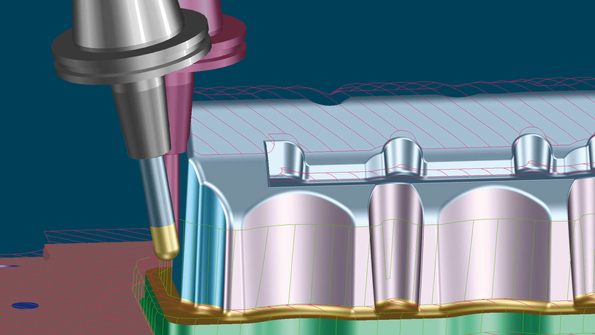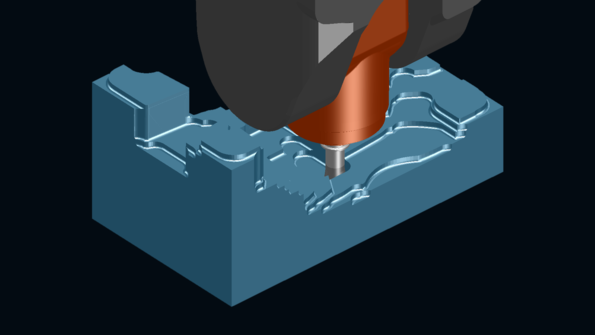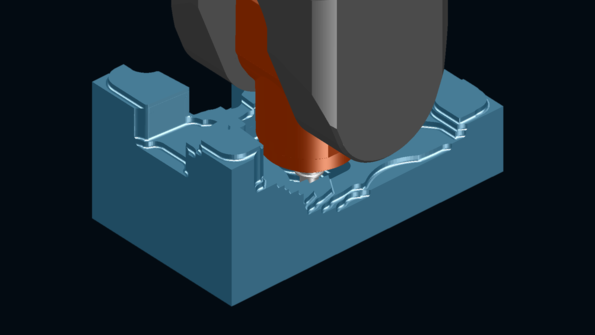-
Software
-
CAM software
- Tebis Automill
- CNC programming
- CNC automation
- CNC simulator
- Multiple setup
- Robotic machining
- CNC drilling
- Deep-hole drilling
- Combined turn-milling
- CNC turning
- Turn-milling
- 2.5D milling
- 3D milling
- 5-axis milling
- Slot milling
- Trimming
- HPC milling
- HFC milling
- Circle-segment cutters
- Sinker EDM
- Wire EDM
- 3D laser cutting
- Laser hardening
- Laser weld cladding
- CAD software
- CAQ software
- MES software
- Products
- Part stories
-
CAM software
- Services
- Consulting
- Sectors
- References
- Company
- News

-

3D milling for roughing and finishing
The reliable and efficient path to premium surfaces
The 3D milling strategies can be used to create 3-axis and 3+2-axis NC programs for roughing, finishing and residual stock machining. You can prevent collisions during calculation. For example, the tool automatically avoids collisions or reduces areas at risk, depending on the application. In conjunction with the precise simulation technologies and harmonic slope-adjusted NC paths, optimal traverse paths are generated for the machine axes in 3D milling.
Top performanceMake the best possible use of modern high-performance tools and benefit from maximum speed and tool life.User-friendlyConvenience with the combination of Tebis template technology and Tebis process libraries.High surface qualityUse Tebis to mill directly on surfaces and precisely control distribution of NC points.The most important strategies for 3D milling
- Direct 3D milling on surfaces
- End-to-end accounting for blanks
- Roughing in planes, protecting tools
- Automatic roughing of planar surfaces
- Equidistant 3D finishing
- Precise accounting for residual stock with material tracking
- Part-oriented curve milling
- Height-sorted fillet machining
- Automated machining of ribs and slots
Prevent unnecessary idle travel during roughing
You can quickly and easily define any blanks. The material can be machined from different tilt directions..This significantly reduces computational effort.The blank is updated and passed on to the next machining operation – and the update is always performed using the actual cutter geometry. The system safely and reliably mills only where there is remaining material.
Tebis uses differentoptions for full-cut handling and full-cut avoidance in 3D milling: Depending on the situation, full-cut areas are machined trochoidally, or the path layout is automatically adapted to the geometry without full-cut machining. This is optimal for adaptive roughing with HPC cutters. All path layouts are also automatically smoothed – enabling further optimization of the feed rate.
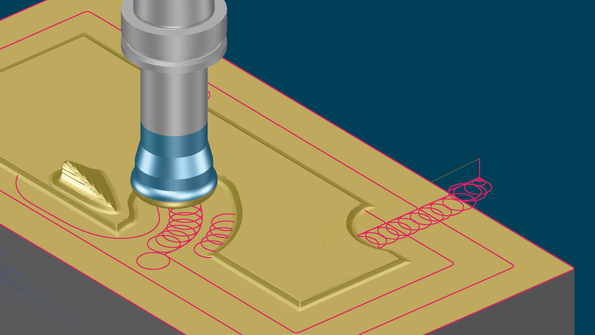 Trochoidal full-cut handling in 3D milling
Trochoidal full-cut handling in 3D milling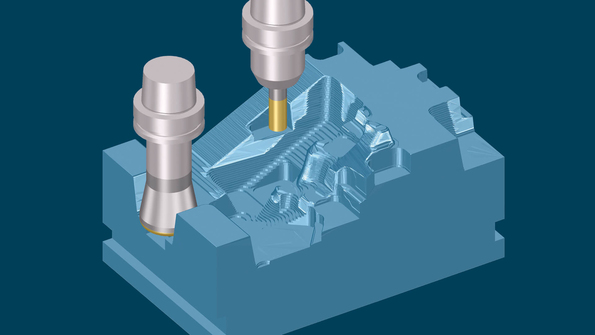 Combine favorite strategies and tools for optimal machining capacity in 3D milling
Combine favorite strategies and tools for optimal machining capacity in 3D milling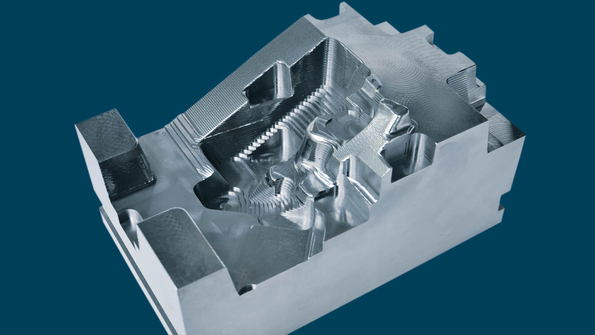
Efficiently machine planar areas
View video / contact formPlease select the Preference cookies to activate the display.Activate cookiesEfficiently machine planar areas.It’s usually more cost-effective to machine the planar areas of a part after hardening with a smaller stock allowance than the non-planar areas Special tool types like large insert mills can then be used in this step. Tebis offers a function that automatically detects purely planar areas on selected part surfaces with no need to further subdivide the part.Finishing for the best surface quality
Tebis strategies for optimized 3D stepoverensure uniform stepover on the surface in 3D milling of both flat and steep areas. The part is automatically subdivided in slope ranges that can each be machined using special strategies and tools – the best prerequisite for automated NC programming in conjunction with Tebis template technology.
High-quality toolpaths: HSC point distributionoptimally positions the NC points on the surface. You can influence the point distribution so that the output toolpaths precisely match your machine control. An additional benefit: You can mill directly on surfaces without needing a faceted substitute model.
Precisely determine milling areas: In Tebis, the contour of the virtual tool matches exactly with that of the actual tool used. You can therefore optimally use the potential of your HFC cutters even for prefinishing.
Optimized 3D stepover for 3D milling
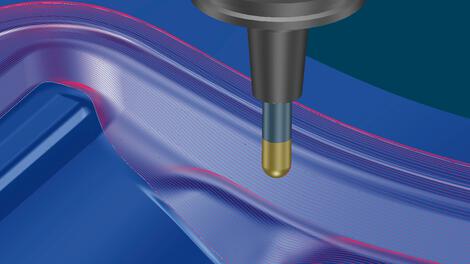
HSC point distribution...
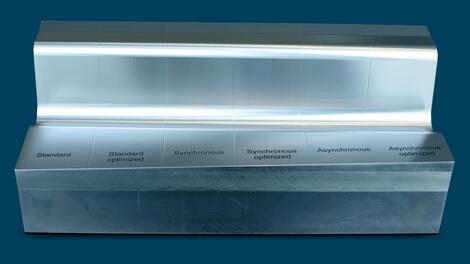
...controlled for your specific machine
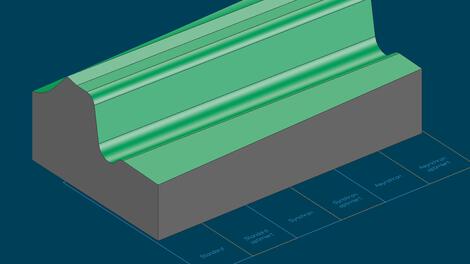 Geometries with steep flank surfaces, straight bottom surfaces and entrance and exit radii – like ribs and slots – can be machined automatically and with a uniform step and 3-axis Z-constant machining – with no retract movements and and with no extra design effort.
Geometries with steep flank surfaces, straight bottom surfaces and entrance and exit radii – like ribs and slots – can be machined automatically and with a uniform step and 3-axis Z-constant machining – with no retract movements and and with no extra design effort.Path and height-oriented residual stock machining
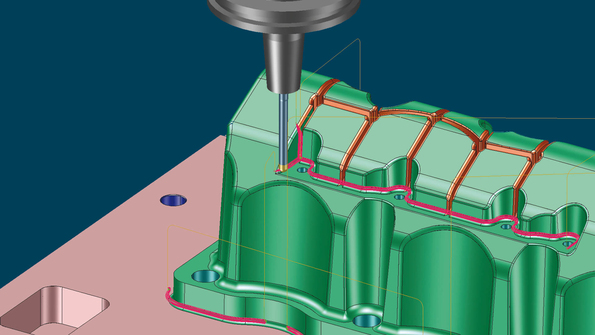 Efficiently machine residual stock in 3D milling
Efficiently machine residual stock in 3D millingDepending on the task, special residual stock machining strategies are available for 3D milling, such as for fillets or complex cavities. Path and height-oriented NC programs reduce machine run times. You also benefit from precise calculation of the milling areas in residual stock machining.
Machine undercuts in a single setup
In multi-sided machining ofundercut areas, you can completely machine the component with key and ball cutters in a single setup. You’llachieve a very high surface quality using the shortest possible tools.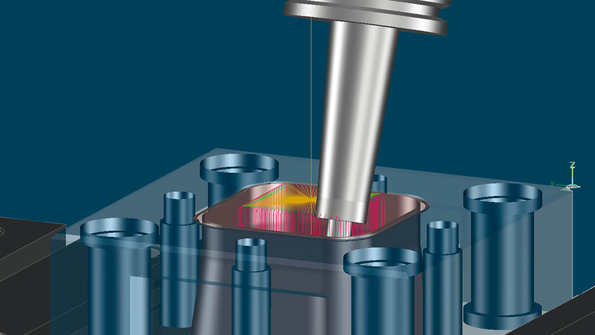
Quickly create collision-checked NC programs
Tebis detects potential collisions automatically during NC calculation. The wide range of collision avoidance solutions are optimized for specific situations.
Area reduction accounting for the real head geometry
In the event of potential collisions with the machine head, milling areas are automatically reduced or excluded from machining. You can increase process reliability and use theshortest possible tools for every job to ensure optimal cutting conditions.The "Programming with virtual machine" license also enables interactive rotation of thehead or tablearound the C-axisin the machine kinematics.The benefit is especially significant for asymmetrical heads: The maximum possible material is removed with the selected tool. Unnecessary residual stock is avoided. The interactive rotations are immediately accounted for in the area reduction.5-axis simultaneous avoidance milling
Collisions of the tool holder with the component in 3+2-axis NC programs can also be prevented with automated 5-axis simultaneous machining. This enables top-quality machining of electrodes or components with deep cavities using short tools.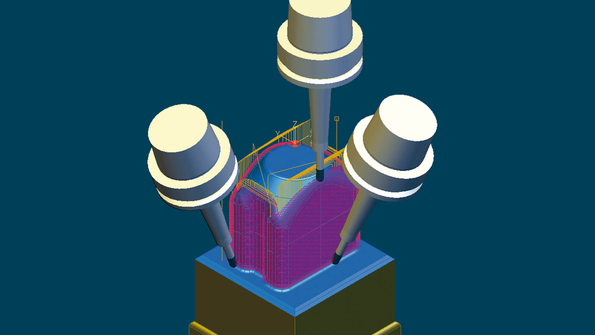
Indexed residual stock programs
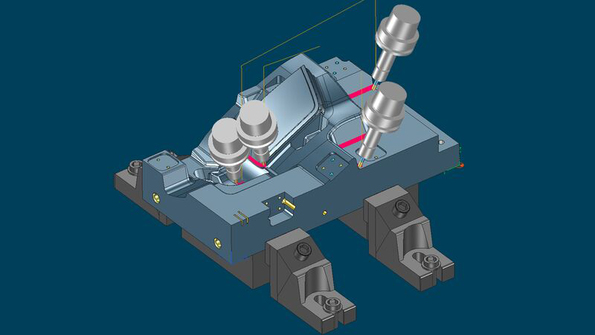
Indexed residual stock programs can also be calculated fully automatically. This reduces machining times on the machine and achieves better surface quality.
Great flexibility through interactive interface
An additional benefit: The tilt direction can be adjusted interactively, enabling you to remain flexible despite the high degree of automation.
